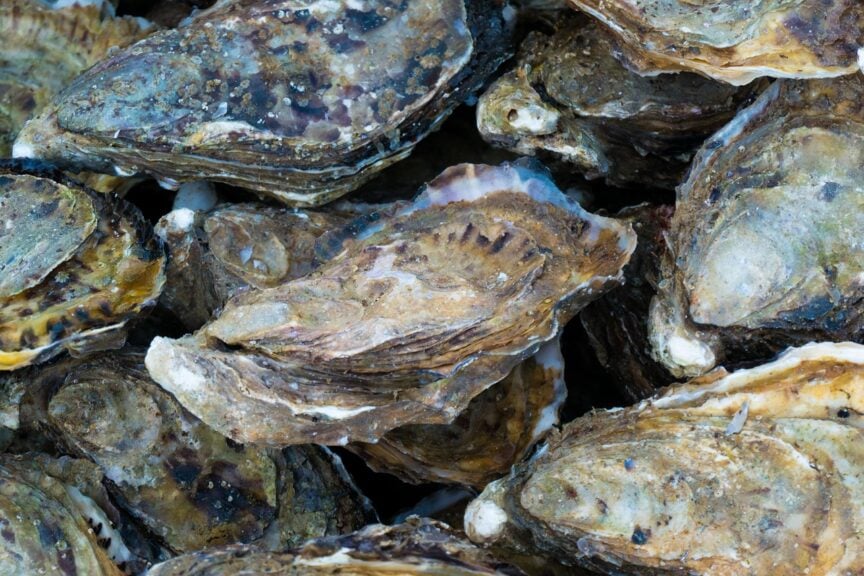This article originally appeared on Inside Climate News, a nonprofit, non-partisan news organization that covers climate, energy and the environment. Sign up for their newsletter here.
LONG BEACH TOWNSHIP, N.J.—Every year, hungry restaurant patrons slurp down fat, juicy oysters, their greyish-white shells cast aside with little thought. But here on this picturesque barrier island, the crusty shells are a valuable commodity and are hauled away by township workers, sorted by volunteers and destined for a whole new life.
Come September, the recycled shells collected over the last few years will become part of a new oyster reef the township is building to help protect its bayside marshland from erosion.
Baby oysters, known as spat, will be added to the mix of recycled shells in a concrete “castle” in a modern-day effort to grow a new colony, which in turn will make the bay healthier.
The job for the small but mighty oysters is a good example of how scientists are turning to nature-based solutions in the struggle against climate change and rising sea levels.
“The concept is as old as the ages,” said Angela Andersen, the township’s sustainability director and project manager for the new reef.
Andersen said the township is the first and only shore town in New Jersey that collects the discarded oyster and clam shells from local restaurants for use in a reef project.
But other governments and organizations are working on a variety of similar projects along the U.S. coastline.
In New York City, the Billion Oyster Project is trying to restore the oyster population that was once so vibrant that early settlers marveled at the giant natural oyster reefs that towered in what is now New York Harbor.
Other states with oyster projects underway include California, Connecticut, Virginia, Maryland, Louisiana, North Carolina, South Carolina, Alabama and Florida.
Some are trying to protect their shorelines, as Long Beach Township is doing, or to save property or help other marine life—such as the horseshoe crabs that need a sandy beach to lay their eggs every spring along the Delaware Bay, where the beach is eroding.
And others are trying to rebuild the oyster population and revive the once-thriving oyster-based economy.
Andersen said the idea behind the township project is to mimic a natural oyster reef, which once grew into large clumps and would intrinsically protect the marshes from wind and waves.
The new reef will consist of bagged and loose shells, along with modified blocks of concrete known as oyster castles, that will be strategically placed in shallow water just off the 22-acre Clam Cove Reserve marsh, which is visible from Andersen’s office at the township marine education center.

The project, which is funded and supported by a coalition of community, environmental and government groups, should help on multiple levels—keeping used shells out of landfills, protecting and enhancing local marine habitat and helping to lessen erosion. And the oyster is the star of the show.
“Oysters are coastal ecosystem engineers,” said Tim Dillingham, executive director of the American Littoral Society, a New Jersey-based coastal conservation nonprofit that is working on several oyster reef projects.
Across Barnegat Bay, in the shallow water off the Forked River bay town, a series of caged units with a mix of shells and rock form segments of oyster reef that was built in 2021 and now is being monitored by Dillingham’s organization.
“It’s very successful so far and it’s definitely meeting the objectives that we set,” said Dillingham, looking out at the reefs one day this month.
He said those goals include helping protect the shoreline, which was battered during Superstorm Sandy in 2012, and encouraging the growth of oysters—which will also make the bay waters cleaner.
Zack Royle, habitat restoration projects manager with ALS who is working on the $1 million project, said that 115 of the reef’s 168 units now have oysters on them, suggesting they are able to latch onto the shells and thrive.
“If you build it, they will come,” said Julie Schumacher, the Littoral Society’s senior habitat restoration coordinator who also is working on the project.
Oysters have been around for millions of years and are tiny workhorses of the water. They filter toxins, leaving their natural habitats in bays with cleaner water. And when they clump together and form reefs, they provide crucial underwater structure for crabs and juvenile fish.
As scientists search for ways to blunt the impact of climate change, they are also seeing that new reefs can be specially designed to protect against coastal erosion by blunting winds and waves and providing a seawall-like buffer for marshes and beaches.
The oyster is also now helping with the nation’s defense.
This story is funded by readers like you.
Our nonprofit newsroom provides award-winning climate coverage free of charge and advertising. We rely on donations from readers like you to keep going. Please donate now to support our work.
At Tyndall Air Force Base in Florida, scientists from Rutgers University in New Jersey are leading a project to test whether a hybrid oyster reef will be effective in protecting the country’s coastal bases around the world from dangerously high winds.
A series of concrete modules was built and installed last fall in the Gulf of Mexico near Tampa, and scientists are watching and gathering data. So far, the data is encouraging.
“We see either a reduction in the rate of erosion, or a build-back of the shoreline,” said David Bushek, the lead scientist on the project and director of Rutgers’ Haskin Shellfish Research Laboratory.
The $11.3 million project was begun after Tyndall suffered $5 billion in damages in 2018 during Hurricane Michael, with winds ripping through buildings, flipping aircraft and flinging around anything not tied down.
Bushek said there is a lot of experimentation going on among scientists about what mix of components and structure are most effective for new reefs to encourage the growth of oysters, protect them from disease and predators and get the desired environmental impact.
The industry, meanwhile, is slowly making a comeback in the Barnegat Bay and in other bays in New Jersey. For decades, dating to the 1880s, the industry had driven local economies up and down the New Jersey coast.
Along the Delaware Bay, Port Norris, for example, was once said to have had more millionaires per capita than anywhere else in the United States. Back then, the oyster was the coin of the realm.
The comeback may be just in time to help ameliorate the impact of sea level rise, which is impacting coastal communities around the world as glaciers melt and ocean waters swell with rising heat.
While denial remains a powerful emotion in many places, shore communities in New Jersey are trying a variety of ways to prepare for rising waters, especially along the back bays.
They are adding pumps and valves, raising roadways, shoring up infrastructure, utilities and emergency services—and turning to nature.
According to the New Jersey Climate Change Resource Center, the sea level at the Jersey Shore has risen 18 inches since the early 1900s—more than twice the global mean rate of about eight inches.
And studies consistently predict that the water will continue to rise—and more quickly thanks to global warming. Estimates vary, though, for how much it will rise, with projections generally forecasting a rise of almost a foot by 2050 and perhaps five feet by the end of the century.
Andersen said communities have to pull out all stops. “Time is not on our side. We have to do all of these things cohesively and comprehensively,” she said.
The process is an all-hands-on-deck effort supported by donations, grants and volunteers. The used shells are collected from local restaurants three days a week and dumped in a yard where they sit and are “cured” by the local elements for about six months.
Volunteers then put them in bags that will eventually get loaded onto a barge and taken out to the grassy green marsh.
The marshes, she said, are as protective on the bay side as sand dunes are on the ocean. “They’re absolutely the book ends holding it all together,” she said.
Local restaurants have enthusiastically agreed to the recycling effort, Andersen said, and the township has volunteers who sort and bag the shells after the shells have been cured and deemed ready for the reef.
At the nearby Delaware Avenue Oyster House, owner Toby Eisenberg said she is happy to be among the restaurants that donate the used shells.
“The shore is changing—I’ve seen it in my lifetime,” said Eisenberg. “Anything that I can do, even if it’s tiny, it’s I think my responsibility.”
Andersen said the project is an example of how local communities can have a special role in helping to deal with climate change. “I hope it becomes a model,” she said.
The “magnificent” oyster, she said, is pointing the way for how nature can lessen the impact of climate change and sea level rise. “Its resurgence,” she said, “is giving us an entirely new blueprint for the future.”
About This Story
Perhaps you noticed: This story, like all the news we publish, is free to read. That’s because Inside Climate News is a 501c3 nonprofit organization. We do not charge a subscription fee, lock our news behind a paywall, or clutter our website with ads. We make our news on climate and the environment freely available to you and anyone who wants it.
That’s not all. We also share our news for free with scores of other media organizations around the country. Many of them can’t afford to do environmental journalism of their own. We’ve built bureaus from coast to coast to report local stories, collaborate with local newsrooms and co-publish articles so that this vital work is shared as widely as possible.
Two of us launched ICN in 2007. Six years later we earned a Pulitzer Prize for National Reporting, and now we run the oldest and largest dedicated climate newsroom in the nation. We tell the story in all its complexity. We hold polluters accountable. We expose environmental injustice. We debunk misinformation. We scrutinize solutions and inspire action.
Donations from readers like you fund every aspect of what we do. If you don’t already, will you support our ongoing work, our reporting on the biggest crisis facing our planet, and help us reach even more readers in more places?
Please take a moment to make a tax-deductible donation. Every one of them makes a difference.
Thank you,
David Sassoon
Founder and Publisher
Vernon Loeb
Executive Editor







